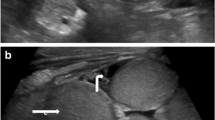Abstract
When presentation is delayed, intussusceptions may be difficult to reduce using standard enema regimens. Our endeavour to minimize the need for surgery in an environment where failed reductions are common has led to the development of an aggressive, non-operative method of reducing intussusceptions.
One hundred and six patients with intussusception were reviewed with the aim of evaluating a new method of reducing intussusceptions suited to our Third World environment. In our cohort, delayed presentation was common, with 32% of patients presenting more than 48 h after the onset of the intussusception. On clinical grounds alone, 41% of patients required a primary laparotomy.
Standard barium and air reductions for intussusception were rarely successful under these conditions i.e. 13% and 22%, respectively. By using an air enema under general anaesthesia in the operating theatre, the reduction rate has improved to 53%.
This approach is suggested as a last attempt at reducing an intussusception prior to laparotomy following failed standard enema reduction, and as the first line of management in the attempted reduction in the patient with delayed presentation without symptoms of peritonitis.
Similar content being viewed by others
References
Pierro A, Donnell SC, Paraskevopoulou C, et al. (1993) Indication for laparotomy after hydrostatic reduction for intussusception. J Pediatr Surg 28:1154–1157
Postma MH, Hadley GP (1985) Intussusception in black children. S Afr Med J 68:405–406
Yang CM, Hsu HY, Tsao PN, et al. (2001) Recurrence of intussusception in childhood. Acta Paediatr Taiwan 42:158–161
Archibong AE, Usoro IN, Ikpi E, et al. (2001) Paediatric intussusception in Calabar, Nigeria. E Afr Med J 78:19–21
Grant HW, Buccimazza I, Hadley GP (1996) A comparison of colo-colic and ileo-colic intussusception. J Pediatr Surg 31(12):1607–1610
Breckon V, Hadley GP (2000) Waugh’s syndrome: a report of six patients. Pediatr Surg Int 16:370–373
Calder FR, Tan S, Kitteringham L, et al. (2001) Patterns of management of intussusception outside tertiary centers. J Pediatr Surg 36:312–315
Maoate K, Beasely SW (1998) Perforation during gas reduction of intussusception. Pediatr Surg Int 14:168–170
Author information
Authors and Affiliations
Corresponding author
Rights and permissions
About this article
Cite this article
Wiersma, R., Hadley, G.P. Minimizing surgery in complicated intussusceptions in the Third World. Ped Surgery Int 20, 215–217 (2004). https://doi.org/10.1007/s00383-003-1099-x
Accepted:
Published:
Issue Date:
DOI: https://doi.org/10.1007/s00383-003-1099-x




